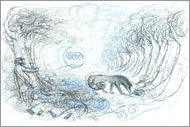The cover picture of Truda Lane’s enchanting book entices us into the world within. Between two lines of trees, an animal (a dog? a wolf? – the caption tells us it is a ‘Wolfish Dog’) sniffs tenderly at a sitting cat. The image is repeated in a floating circle. A girl in cloak and scarf clutches a tree trunk for support, for the wind is blowing fiercely through the branches. At her feet, birds peck the ground for food. Flakes of snow are falling, and there are stars in the sky. The dog, the caption continues, transformed an everyday landscape into something remarkable.
And here is one clue to the particular magic of these drawings. The world they depict is indeed everyday, and firmly rooted in reality. The buffeted trees, for all their rhythmic movement, are solid objects, the history of their growth delineated in their knobbly twisted trunks. Whenever buildings appear, they are not only carefully observed: they are real structures, with their lintels, keystones and cornerstones.
Truda Lane, in her Introduction, describes structure as the source of life, dynamic energy and movement, and of course she means the structure of the whole drawing. She defines a good drawing as one that you can set bones from, and within this structure little bits of magic are occurring.
A Derbyshire farmhouse is lit up by a glimpse of the fiery sun. “As we stopped to buy eggs,” the artist explains, “the woman of the house excitedly announced that the sun was about to appear round the hill for a brief few minutes, the only time during the day it could be seen”. At the top of the steps against a Devon stone barn, a boy is waving a sparkler around, the brightly coloured sparks echoing the pale stars in the night sky above. “There is still some magic left”, the title informs us, and it is this magic that informs these drawings and watercolours.
The subject matter can be classical myth or fairytale, small observation or works of literature. One wonderful watercolour is inspired by T.S. Eliot’s Ash Wednesday: “Lady, three white leopards sat under a juniper tree | In the cool of the day…” The first stars of the evening are in the sky, and a skull and bones lie nearby. In the poem, the bones sing: “We are glad to be scattered, we did little good to each other.” In the watercolour, they say, “Sancta Maria ora pro nobis” – Blessed Mary, pray for us.
We encounter a Creation Myth. We meet Aengus, the Celtic God of Youth, sitting under a tree with his four birds round his head, and a leopard and butterflies nearby. A Greek boy, Melampus, buries a dead serpent, and her children lick his ears to reward him with the gift of understanding animal speech. And the winter sun is buried under the earth, a North American myth. Yet the domestic is never far away – a decorated soup tureen, a bowl of fruit, a vegetable garden, a cat curled up on a cushion.
For all the delicacy of line, these pictures are full of energy and movement. The trees, which inhabit many of them, have the vigour of their growth enshrined in their trunks, and their branches are blown by the wind, as the rushing deer run through them. “Stones have been known to move, and trees to speak,” said Macbeth, and these trees speak to us. Indeed, the title of one of the sections is Speaking Trees.
In his perceptive Foreword, John Moat places Truda Lane amongst those artists – many of them women – “who bring to their work a vision so innately their own…that we tend to view them as apart from their time, impossible to categorise, and so perhaps eccentric”. He cites women novelists, poets and painters Emily Dickinson, Stevie Smith, Jean Rhys, Ivy Compton-Burnett, Gwen John, Winifred Nicholson, Mary Newcomb; but he could have included at least one man, David Jones, also quite out of the mainstream – a writer and artist who shared similar sources with this artist: myth, fairy tale, literature and the natural world.
This book will be a revelation to most of those who come across it. It has been beautifully designed by Simon Wilby, and as the recent exhibition of Renaissance drawings in the British Museum showed, drawing is the most intimate of arts, where you feel closest to the artists themselves. These drawings and watercolours speak very directly of the inner life of Truda Lane. They are indeed lifelines, which tell a story of an English landscape, and a very English imagination.
To order your copy of Lifelines, go to: www.resurgence.org/shop







